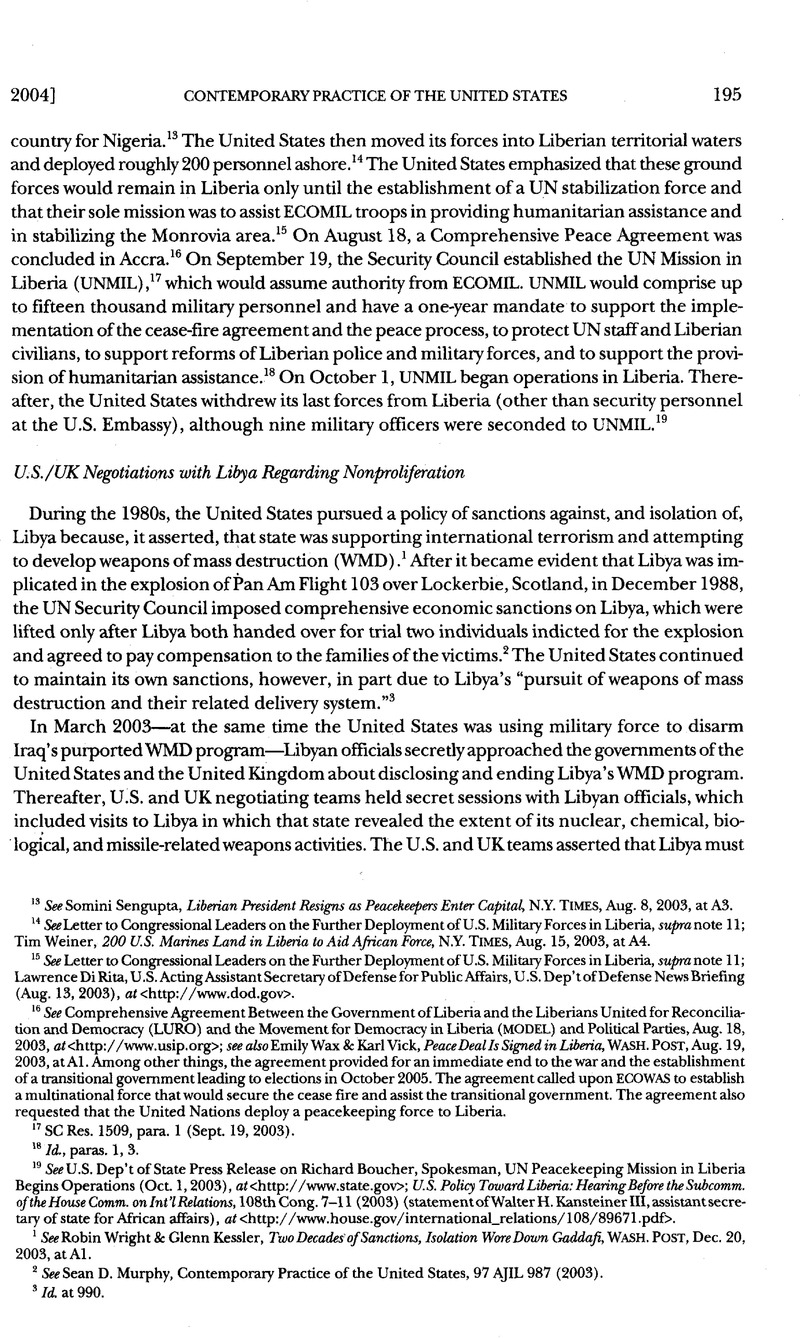Article contents
U.S./UK Negotiations with Libya Regarding Nonproliferation
Published online by Cambridge University Press: 10 March 2017
Abstract

- Type
- Contemporary Practice of the United States Relating to International Law
- Information
- Copyright
- Copyright © American Society of International Law 2004
References
1 See Wright, Robin & Kessler, Glenn, Two Decades of Sanctions, Isolation Wore Down Gaddafi, Wash. Post, Dec. 20, 2003, at A1.Google Scholar
2 See Sean, D. Murphy, Contemporary Practice of the United States, 97 AJIL 987 (2003).Google Scholar
3 Id. at 990.
4 See Frankel, Glenn, “A Long Slog” Led to Libya’s Decision, Wash. Post, Dec. 21, 2003, at A28.Google Scholar
5 [Editor’s Note: See Missile Technology Control Regime: Agreement on Revised Guidelines for the Transfer of Equipment and Technology Related to Missiles, Jan. 7, 1993, 32 ILM 1298 (1993). As of December 2003, Libya is not a participant in this regime.]
6 [Editor’s Note: See Treaty on the Non-proliferation of Nuclear Weapons, July 1, 1968, 21UST 483, 729 UNTS 161. Libya became a party to the Convention on May 26, 1975.]
7 [Editor’s Note: See Agreement for the Application of Safeguards in Connection with the Treaty on Non-proliferation of Nuclear Weapons, July 8, 1980, IAEA-Libya, 1227 UNTS 161. The IAEA concludes “safeguards agreements” with states to secure commitments (such as acceptance of IAEA on-site inspections) that allow the IAEA to verify that states are living up to their nonproliferation obligations.]
8 [Editor’s Note: See Convention on the Prohibition of the Development, Production and Stockpiling of Bacteriological (Biological) and Toxin Weapons and on Their Destruction, Apr. 10, 1972, 26 UST 583, 1015 UNTS 163. As of December 2003, Libya is not a party to this Convention.]
9 [Editor’s Note: The IAEA has developed an “additional protocol” to its standard safeguards agreement; the protocol is designed to provide the IAEA with expanded rights of access to information and sites in the states that conclude such an additional agreement. See International Atomic Energy Agency, Model Protocol Additional to the Agreement[s] Between State [s] and the International Atomic Energy for the Application of Safeguards, IAEA Doc. INFCIRC/540 (Sept. 1997), at <http://www.iaea.org>. As of December 2003, Libya has not concluded such a protocol.]
10 [Editor’s Note: See Convention on the Prohibition of the Development, Production, Stockpiling and Use of Chemical Weapons and on Their Destruction, Jan. 13, 1993, 1974 UNTS 45, 32 ILM 800 (1993). As of December 2003, Libya is not a party to the Convention.]
11 [Editor’s Note: For a discussion of efforts to establish a verification protocol for the Convention on Biological Weapons, see Sean, D. Murphy, United States Practice in International Law, 1999–2001, at 455 (2002)Google Scholar.]
12 Communiqué of the Libyan Arab Jamahiriya, appended to Letter Dated 19 December 2003 from the Permanent Representative of the Libyan Arab Jamahiriya to the United Nations Addressed to the President of the Security Council, UN Doc. S/2003/1196 (Dec. 29, 2003).
13 Remarks on the Decision by Colonel Muammar Abu Minyar al-Qadhafi of Libya to Disclose and Dismantle Weapons of Mass Destruction Programs, 39 Weekly Comp. Pres. Doc. 1835, 1835-36 (Dec. 19, 2003).Google Scholar
14 IAEA Press Release on IAEA Director General to Visit Libya, No. 2003/14 (Dec. 22, 2003), at <http://www.iaea.org>.
15 See Williams, Daniel, U.N. Team Arrives in Libya to Open Talks, Wash. Post, Dec. 28, 2003, at A16.Google Scholar
16 Patrick, E. Tyler, Libya’s Atom Bid in Early Phases, N.Y. Times, Dec. 30, 2003, at A1.Google Scholar
17 See Patrick, E. Tyler, Libya Presses U.S. to Move Quickly to End Sanctions, N.Y. Times, Jan. 2, 2004, at A1.Google Scholar
18 See IAEA Press Release on IAEA, US and UK Discuss Libya, No. 2004/01 (Jan. 14, 2004), at <http://www.iaea.org>; see also Slevin, Peter & Warrick, Joby, U.S. Will Work with UN. Agency in Libya, Wash. Post, Jan. 20, 2004, at A13.Google Scholar
19 Comprehensive Test Ban Treaty, Sept. 10, 1996, GA Res. 50/245 (Sept. 10, 1996).
- 1
- Cited by




